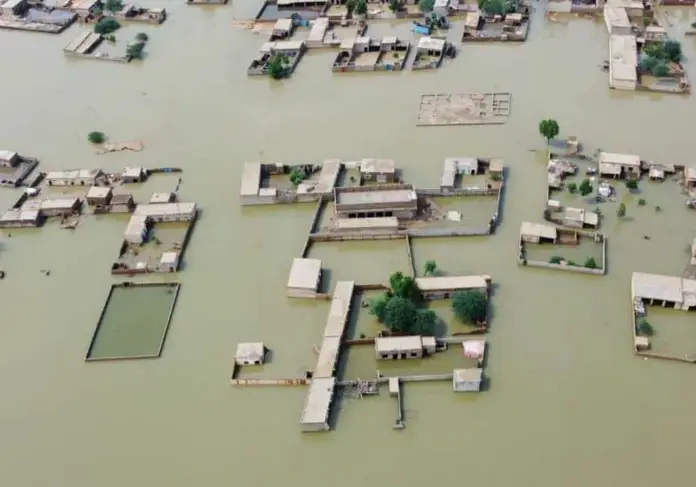At the present time, Pakistan is confronting myriad daunting challenges. One of the most threatening is flooding. The humanitarian crisis is at its climax. The wave of fear and dread prevails every day with torrential water. Monsoon has become doom soon. The set of circumstances depicts water will shed everything and soon all will be doomed. The fault is not with water, not with people, it is the fault of management. Our fragile governance has miserably failed to curb such uncertainties. The death of five brothers along other hundreds is the testimony of the negligence and divided culture of the heads of state. Ostensibly, the 2022 flood has been a big reveal. It has exposed the faultlines of governance.
However, it is a demonstration of what we have not learned from our past experiences. How can we turn a blind eye to the long-lasting effects of the 2010 flood?
Alas! After a long decade, we are in the same boat where we were before. It would be appropriate to cite here George Hegel’s one aphorism, ‘we learn from history that we do not learn from history.’ Repetition of natural disasters is quintessential of unlearned history. No one is gallantly volunteering to learn from the past.
Only a few have the mighty ocean of will to correct the system. Making and implementing policies has become a pipe dream. The leadership race has damaged the country’s outlook. When calamities strike, usually it unites nations. Haplessly, not in Pakistan. Though apart from political rifts, it is time to policies over politics, it is time to unite for national purposes and for people who are grappling with the severe menace of the flood.
In order to prevent future floods and other calamities infrastructural reforms are immediately required. What is needed is holistic and sustainable measures that can assist a country to get rid of annual floods and other challenges such as ecological collapse.
Primarily, we need to imitate the Chinese model of sponge cities to prevent flash floods in Pakistan. Faced with worsening urban floods, cities in China are embracing nature and building what is termed “sponge cities.” Instead of relying on the “grey infrastructure” of levees, pipes, dams and channels, (no doubt a good option) but sponge cities allow urban areas to absorb water in times of high rainfall and release it in times of drought. These cities are highly effective and designed so that rainwater is kept and absorbed where it falls through the sustainable urban drainage systems. It will not only save people from mass destruction but also aid in containing water in times of water scarcity.
Do not forget that we are the most water-stressed country at this moment. According to UN Development Programme, the water-shortage capacity available in Pakistan is 121 cubic meters per person. Per capita surface water availability of 5,260 cubic metres per year in 1951 turned into around 1,000 cubic metres in 2016. This is likely to further drop about 860 cubic meters by 2025.
Secondly, in green infrastructure, we can design water parks, drainage pavements, rain gardens, infiltration and garden wells, urban gardens, and plantations. It is worth remembering that investing in green infrastructure is not simple but also not a herculean task. It takes time but is a valuable implementation.
Thirdly, harvesting rainwater, this method is practicable in urban and rural arena. A number of people harvest rainwater to wash clothes and cars, garden and flush toilets in Denmark. Owing to the successful execution of rainwater harvesting, the Danish community was awarded a Scandinavian environmental prize in September 1998.
Lastly, grey infrastructure, the construction of large- and small-scale dams is the ultimate solution to avert floods. Since Pakistan does not have enough dams, it results in flooding every year during the season of monsoon. These dams need to be built across the country to store excessive water and ward off future flooding disasters. Adaptation of measures is the need of the hour.
According to National Disaster Management Authority, floods have wrought the destruction of epic proportions. 1,500 deaths, more than 33 million people — including 11m children — have been severely impacted. A large portion of infrastructure has been affected by more than 375 bridges and almost 13,000 kilometres of roads have been washed away. Over 1.9m homes have been damaged, while 2.8m hectares (around 7m acres) of agricultural land in Sindh is submerged.
At the same time, the floods have caused massive damage to livestock that serves as a primary asset for poor people, as almost a million animals have perished in the deluge. About 4.6 million people are in dire need of humanitarian aid. The situation is getting awful with each passing day.
People are in severe crisis. Flood 2022 devastation is massive. It has not only caused economic loss but also human, parental, emotional, and intellectual loss. Inundated water has shed its entirety. People do not have a single thing for physical survival. How they will forget this huge catastrophe? Does anyone have any idea? Sadly, badly, no one. Nothing can subside their pain but we can try to heal their wounds with compassion, love, and kindness.
Displaced bodies, shelterless heads, empty hands, restless eyes, and sad faces have nothing to survive, yet hope. Being their last hope and being human, we should come forward to help them. We ought to feel the agony and sufferings of humanity and our heart should bleed for them it is the real beauty of being human. Pakistan is going through one of the most arduous episodes of current and chronicle challenges. Heart-wrenching images and viral video clips demand serious attention.
Undoubtedly, being a developing country Pakistan spends 2.5 of its GDP on charity compared to 2.2 percent in the USA, 1.3 percent in the UK and 0.2 percent in India.
Pakistan should try to stand first in good governance as well. Although, in times of crisis individual and collective hands have always been laudable. NGOs, welfare foundations and different trusts are working day and night to facilitate flood affectees. Sadly, people are still vulnerable. Their primary needs are yet to be catered hitherto. It is the most appropriate time to support them financially, morally and mentally. Undeniably, it will take years to unmark the marks of woes and sorrows of the flood. Nevertheless, time will heal lest another cataclysm occurs.
On the contrary, donations and economic assistance are not long-term solutions, the government of Pakistan needs to adopt a blend of pragmatic, holistic and sustainable measures to save the country from upcoming misadventures. Antifragile systems are still possible. The principle of Acta non-Verba (deeds not words) would be highly appreciated.







